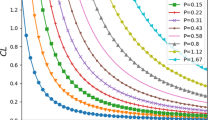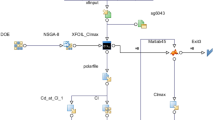Abstract
Laminar airfoil has extensive application prospect because of its low drag characteristic. In order to optimize the high lift-drag ratio airfoils of solar powered unmanned aerial vehicles in near space at low Reynolds number, the research on FX63-137 airfoil has been conducted. Firstly, numerical simulations are carried out using both transition SST model and transition \(k - k_{L} - \omega\) model, and are compared with the wind tunnel test results. Secondly, the parameterized modeling method and optimization algorithm for the airfoil are applied, and an airfoil optimization design platform has been built. An optimized airfoil has been designed based on FX63-137 airfoil using the platform. Results show that, the maximum lift-drag ratio of the optimized airfoil is increased by 6.83%, and the pitching moment is reduced by 0.015, which further improves the aerodynamic characteristics of FX63-137 airfoil and reduces the influence of trimming on aerodynamic efficiency.
Access this chapter
Tax calculation will be finalised at checkout
Purchases are for personal use only
Similar content being viewed by others
References
Shi, W., Jia, Y.Q., Li, G.J., et al.: Analysis of the main technical problems of high-altitude long-endurance solar-powered UAVs. Aerodyn. Missile J. 6, 63–66 (2021)
Li, F., Bai, P.: Low Reynolds Number Aerodynamics of Aircraft, p. 3. China Aerospace Press, Bei**g (2017)
Munday, P.M., Taira, K., Suma, T., et al.: Nonlinear lift on a triangular airfoil in low-reynolds-number compressible flow. J. Aircaft 52(3), 924–931 (2015)
Mueller, T.J.: The influence of laminar separation and transition on low Reynolds number airfoil hysteresis. J. Aircr. 22(9), 763–770 (1985)
Yang, Z., Igarashi, H., Martin, M., et al.: An experimental investigation on aerodynamic hysteresis of a lowreynolds number airfoil: AIAA-2008-0315. AIAA, Reston (2008)
Liu, P.Q., Ma, L.C., Qu, Q., Duan, Z.Z.: Numerical investigation of the laminar separation bubble control by blowing/suction on an airfoil at low Re number. Acta Aerodynamica Sinica 31(04), 518–524+540 (2013)
Chen, X.K.: Aerodynamic Optimization and Application of Low Reynolds Number Airfoil. National University of Defense Technology, Changsha (2011)
Yu, B., He, X., Deng, H.: Optimization design of airfoil on new energy UAV based on CST method. Aeronaut. Sci. Technol. 30(10), 24–29 (2019)
Li, D.C., Yang, L., Wei, C., et al.: Study on multi-point aerodynamic optimization method of low Reynolds number airfoil. Aeronaut. Sci. Technol. 31(12), 16–25 (2020)
Wang, K.L., Zhu, X.P., Zhou, Z., Xu, X.P.: Studying optimization design of low Reynolds number airfoil using transition model. J. Northwestern Polytech. Univ. 33(04), 580–587 (2015)
Jan, W., Ulrich, S., Rolf, R.: Validation of the RANS—simulation of laminar separation bubbles on airfoils. Aerosp. Sci. Technol. 10, 484–494 (2006)
Liu, F.W., Sun, Y.: Multi-objective optimization of aerodynamic performance of rotor airfoil with low-Reynolds number. Mech. Electr. Eng. Technol. 44(3), 29–33 (2015)
Walters, D.K., Cokljat, D.: A three-equation eddy-viscosity model for Reynolds-averaged Nasiver-Stokes simulations of transitional flows. J. Fluids Eng. 130(1), 1–14 (2008)
Selig, M.S., McGranahan, B.D.: Wind tunnel aerodynamic tests of six airfoils for use on small wind turbines. J. Solar Energy Eng. 126(4), 986–1001 (2004)
Grasso, F.: Development of thick airfoils for wind turbines. J. Aircr. 50(3), 975–981 (2013)
Author information
Authors and Affiliations
Corresponding author
Editor information
Editors and Affiliations
Rights and permissions
Copyright information
© 2024 Chinese Society of Aeronautics and Astronautics
About this paper
Cite this paper
Yu, H. et al. (2024). Research on Optimization Design of Low Reynolds Number Airfoils Based on CFD. In: Proceedings of the 6th China Aeronautical Science and Technology Conference. CASTC 2023. Lecture Notes in Mechanical Engineering. Springer, Singapore. https://doi.org/10.1007/978-981-99-8864-8_16
Download citation
DOI: https://doi.org/10.1007/978-981-99-8864-8_16
Published:
Publisher Name: Springer, Singapore
Print ISBN: 978-981-99-8863-1
Online ISBN: 978-981-99-8864-8
eBook Packages: EngineeringEngineering (R0)




